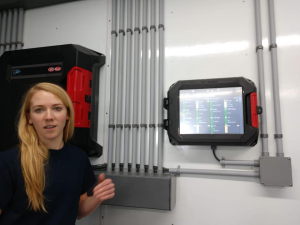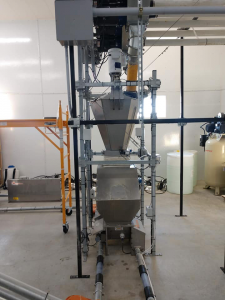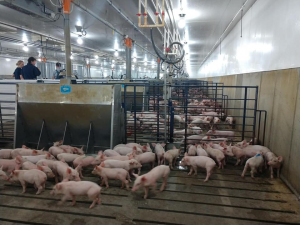I’m a farmer, but I used to be a big-city girl — at a time during my 20s when felt I should only eat meats with the best-sounding labels on them.
While there’s nothing inherently wrong with buying some of those kinds of products, for me, I felt guilty back then that if I wasn’t buying these labels, I was part of the “problem” of an agricultural system that many saw as too big and detached.
“Factory farming” was a term that used to frighten me. I was under the impression these animal were raised in cruel conditions by corporations that didn’t care. That animals were pumped full of hormones and antibiotics, and that all the “factory farms” cared about was profit.
I was wrong.
After becoming a farm writer and advocate for agriculture, I wanted to know the truth and see the reality with my own two eyes, and all I can say is WOW. I am beyond impressed with what I’ve seen. I’ve been to dozens of “factory” farms now and realized that nearly all farms are actually owned by families who really care. They’re business people, and to make a business grow, you have to create a good and healthy product. This means mitigating risk, using fewer inputs, less antibiotics (hormones are not even used in pig farming), and put their care first.
One farm experience I went to recently was in southern Minnesota. A pig farm (raising pork for Schwartz Farms Inc.) and feed research facility for Hubbard Feeds and Alltech, run by Melissa and Jamie Pietig. With agriculture degrees from South Dakota State University, the Pietigs are a young farming couple fully embracing modern tech on their farm, built in 2017. When you first walk in, you see posters that explain regulations and the top-notch care the animals receive. Everything is disinfected, and you’re required to shower and change into clothes and boots they provide, so as to not bring in any outside diseases. These biosecurity efforts mean that these modern farms are now able to raise a vast majority of their pigs with no antibiotics, ever. Years ago when pigs were raised in outdoor lots, they were much more susceptible to disease and to the elements — the flu or other diseases, predators, and harsh weather. There were a lot more antibiotics back then, and protocols weren’t nearly as strict as they are now.
Thank you, technology! And when you first walk into their farm, you’re greeted with with this edge controller Automated Production Cumberland System by AGCO. These high-tech farm “brains” will email the operators if the temp gets too hot or cold, if the feed isn’t dispersing correctly, or if filters or alarms aren’t working right. It’s connected to backup data and power generators and the piglets come onto the farm shortly after they’ve been weaned. The comfortable 84 degree temps for smaller piglets slowly works its way down as they grow.

The piglets at the Pietigs’ farm are vaccinated through separate water lines at first and the feed room (shown below) is pristinely clean.

It’s impressive, and the piglets are weighed every 10 days to measure their progress as the feed research trials carry on. They’re measuring rate of gain, feed conversion, health, and well-being, and they measure meat and carcass quality all the way up until the finished product.
This barn consists of 5,000 pigs (twice a year — 10,000 for a full year), which are brought in at around 18 to 20 days of age and within 14 days of that are eating a pound of food per day. They’ll continue to grow and eat up to eight pounds per day closer to market weight, so the feed trials can be nursery or finishing trails in all different aspects of growth. It’s quite interesting! This is called a “wean-to-finish” operation and is how they are able to use science-based evidence and solid research in controlled environments to produce better quality pork with fewer resources.

What’s some of the research they discovered? Adding lactose to the piglets’ diet equals a healthier pig. Gut health is better overall with improved nutrition. Vaccines are better now, which cuts down on disease and meds, and keeping the pigs clean and healthy means their manure drops through a slatted floor. The manure pit is pumped once a year and is used as fertilizer on nearby farm fields, which farms oftentimes have to have manure management plans per EPA regulations to protect the environment. As the pigs grow, half of them will be sold or moved to another farm so they’re not so cramped for space.
Overall, it’s just incredible, and I wish every consumer could see this to have such a better understanding of just how humane modern “factory” farms really are. The whole time I was wishing our farm had some of this tech, but am also pretty proud of what we do as well in a more “old school” way. Ha.
The moral of the story? Buy what you like, what makes you feel good. Buy what tastes the best, whatever is on sale, whatever you choose. But just know that any farmer can do an excellent job creating a sustainable product regardless of size or marketing label, and think twice when you hear the term “factory farm” — it’s best to go tour one for yourself! You just may be pleasantly surprised. I know I am.
Michelle Miller, the Farm Babe, is an Iowa-based farmer, public speaker, and writer, who lives and works with her boyfriend on their farm, which consists of row crops, beef cattle, and sheep. She believes education is key in bridging the gap between farmers and consumers.



